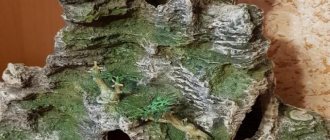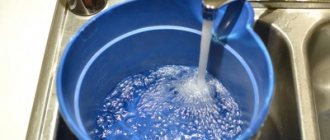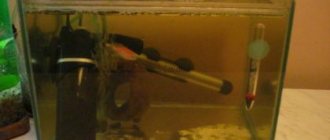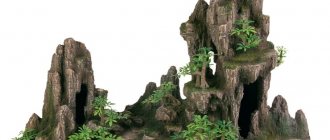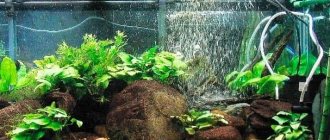Every aquarist wants the aquarium to look well-groomed, but this is not always possible to achieve. No one argues that a container with colorful and bright fish can transform a room and give the interior originality, but if you show imagination and ingenuity, you can make the aquarium even better. You can diversify the underwater space using decorations made from original materials of natural origin. A coconut looks unusual and beautiful in an aquarium. This element can be used for decoration and as a shelter for fish, fry and other underwater inhabitants.
Benefits of using coconut
The beauty and unusual appearance of an artificial pond is given by various decorations, most of which can be purchased at pet stores. However, often many store-bought fragments are made of harmful materials or contain low-quality impurities, which has a bad effect on the health of underwater inhabitants. A safe alternative to plastic decorative elements is a coconut cover for an aquarium, because the nut is of natural origin and looks original in the water column.
A coconut in an aquarium not only decorates the underwater world, but also has many useful benefits:
- the fruit shell is resistant to prolonged exposure to moisture;
- a coconut has negative buoyancy, so it instantly sinks to the bottom;
- is a natural product and absolutely safe for aquarium inhabitants;
- looks beautiful and original;
- coconut is bactericidal, which eliminates the risk of microbial development in the aquarium;
- The fruit shell is not subject to rotting and destruction in water.
Thus, properly processed coconut is excellent for decorating artificial ponds.
How to make an aquarium house from a coconut shell
Many aquarists are offered ideas for decorating housing for fish using various compositions. This topic is constantly open, as the space for imagination is constantly expanding. The aquarium landscape can be diversified using natural materials and plants. What about coconut? Coconut in an aquarium is an extremely useful and necessary item that will delight your fish. We can assume that the house for animals is ready, you just need to spend a small amount of money and physical effort. Coconut shells do not rot in water, are easy to process and do not contain harmful impurities. With its help you can make useful crafts with your own hands.
Coconuts have negative buoyancy and have a beautiful appearance, so fish and crustaceans will be happy. The following aquatic inhabitants will accept coconuts as personal shelter for aquariums:
- Small cichlids (Apistogramma, Etroplusus, Lilioupi-lamprologus, Tropheus, Ramirezi, Nanochromis, Palvicachromis and others);
- Catfish Loricaridae;
- Crayfish and shrimp;
- Boots;
- Plecostomus, Panaka and Ancistrus.
Coconut shell decorations
Everything that is made independently always has an original and unique shape. In the process of decorating an aquarium, you can gain creative inspiration and create even more. You can make decorations from scrap materials, but it is important that they do not release harmful toxic compounds into the water. It is better not to use materials with carbonates - they can rot and increase the level of water hardness. Granite and basalt can protect the lives of fish, but coconuts are perhaps one of the few materials that is affordable and safe.
Pots for aquatic plants, shelters for crustaceans and fish, grottoes and caves are made from coconut shells. This material does not deteriorate and has a natural appearance.
To make beautiful houses, you need a few ripe and high-quality coconuts, a knife, a hacksaw for cutting metal, pliers and a drill.
See how catfish like the coconut grotto.
How to properly prepare coconuts for finishing
Before preparing the material for the aquarium, you should crack the nut and cut it correctly, giving it the required shape. To prevent the shell from deteriorating and falling apart into small fragments, you should carefully select the tools. It is most convenient to use a hacksaw, a hammer and a drill. Further, other tools can be used to process the nut.
All coconuts have a so-called “back part”, on which there are three holes covered with film. By shaking the coconut, you can hear the sound of splashing milk - the “calling card” of a fresh coconut. If after shaking such a sound is not detected, this is a clear sign of an acidified or rotten product; it is better to throw it away without eating it. It is especially not suitable for aquarium fish due to its rigidity.
Using a sharp and thin object (a drill is very convenient), these holes need to be opened by pouring or drinking the milk contained in the coconut. After freeing the nut from liquid, you can safely begin processing. But first, decide what you want to make – a fish house or a boat. If the first, you should separate the back part of the nut, if the second, cut it along the line of connection of all parts.
If you want a result with straight lines, use a hacksaw; if you are happy with chaotic pieces of irregular shape, use a hammer.
How to make coconut houses
A coconut house is a wonderful composition, the manufacture of which requires physical diligence and precision. Coconut shells are 3-5 mm thick, so decide on the width of the hole in advance. Please note that after separating the back part, shavings will fly and the pulp will have to be scraped out. A half-sawn nut will also look ugly, so here you need to find a “golden mean”.
Using a hacksaw, “saw off” part of the coconut with three closed holes, after which the white flesh will appear. It is not soft, and it is not easy to get it out even with a good kitchen knife. First, decide what you need the coconut meat for - for food or other culinary needs. Secondly, find a good knife with a thick blade, gradually peeling the pulp away from the walls of the nut. This is best done by making a cut towards the center of the coconut, and making the same cuts around the circumference. The “procedure” will take a lot of time.
Watch a great master class from Good Dad
Coconut boat
At first glance, it’s easier to make such beauty, but even here it will take time and effort. Holding the coconut in your hand, find the lines that connect the halves of the nut. If you saw these lines, you can get two parts that resemble a boat. Separating coconuts lengthwise is more difficult than crosswise; the hacksaw blade can slip, injuring your hand.
It is easier to make cuts along the line of connection of the shell walls incompletely, by splitting the nut completely with a hammer. It is much easier to remove the pulp from such a coconut.
Watch the fish swim around the coconut grotto.
Preparing coconut for the aquarium
Before placing sawn coconuts for the aquarium, it should be soaked in water for several days (changing the water every 12 hours), after cleaning the inside of any remaining pulp using a hard kitchen sponge or steel wool. After lying in the water for a few more days, it is perfectly cleaned. If you leave the nut in the water or boil it in water for 10 minutes, it will no longer stain the aquarium water, and the material itself will not harm the fish.
There is an opinion that after placing a coconut in an aquarium, the health of the fish worsens. This may be due to the chemicals with which the product was treated before being served on the counter. But during boiling, some microbes and toxins are destroyed, so there are already prerequisites for trust. In addition, few people have come across such low-quality coconuts - commodity experts are well versed in the products.
After all the procedures, the coconuts can be cooled by carefully lowering them to the bottom of the aquarium. You can make a house covered with Java moss - it will look organic and attractive. But keep this in mind: large fish can get stuck in a coconut, so be guided by the size of the aquarium animals.
Coconuts for an aquarium are an excellent decoration that creates the presence of a tropical pond indoors. The small underwater world will delight both the inhabitants of the aquarium and everyone who loves to contemplate it.
>
How to choose a good nut
It is best to purchase coconut without any packaging, so that you can evaluate it visually and by touch. What a fresh and good nut should be like:
- the surface of the fruit is light, smooth, without chips, cracks or flaws;
- there should be no soft areas on the fruit;
- when shaking inside the nut, you can hear the characteristic loud gurgling of liquid;
- three eyes - the place where the fruit is attached to the branch must be dry, neat, without mold or rot;
- when pressing on the shell with a finger, there should be no dents left;
- The fruit is dry and heavy to the touch.
If at least one of the above signs is not true, you should not buy such a nut - it may be spoiled, and instead of bringing hope, it will bring disappointment.
Second step
At this stage, they extract the pulp from the fruit. There are three methods for this:
- Removing the pulp by scraping. The contents of the fruit are removed with a knife. Carefully cut the pulp into small pieces. Judging by numerous reviews, the method is quite labor-intensive. You should also be as careful as possible to avoid cutting yourself.
- Use of ants. This method is used in summer. Just leave the sawn pieces of nut on the anthill for a while. The red ants will do the rest.
- For sourdough. In this case, there is no need to saw off the shell. Craftsmen make several holes in the nut and place it in the sun in a tight bag. You need to leave the milk. I saw the fruit at the end. Under the influence of high temperature, a paste is formed from the liquid, which is easy to obtain.
Do-it-yourself coconut preparation
After purchase, the coconut must be prepared for immersion in the tank. You cannot use unprocessed nuts - its service life depends on how correctly the coconut is prepared for the aquarium.
Basic tools required:
- knife;
- drill;
- hacksaw;
- pliers.
Preparing to dive into the tank will not take much time, even for a beginner in aquarium keeping, if you take precautions and follow the instructions below. Processing stages:
- cutting the fruit;
- content extraction;
- cut holes;
- neutralization of color by cooking or soaking;
- placement in an artificial pond.
To make a coconut for an aquarium with your own hands, first you cut it down. Inside the fruit splashes delicious milk, rich in nutrients and microelements. Therefore, first they make a small hole in the coconut and pour the juice into a separate container. In the future, you will not need milk and you can drink it.
After draining the juice, cut the coconut using a hacksaw. It is more difficult to divide the fruit lengthwise than crosswise, so you should be careful when cutting. There is also a high probability that when separated, pieces of coconut shavings will fly in different directions.
As soon as the nut is no longer whole, the white pulp is extracted from it. This is done using the following methods:
- Scoop out the pulp using a sharp knife. This is a labor-intensive process, since the pulp fits tightly to the shell.
- The contents of the fruit are fermented. To do this, the nut is wrapped in a bag and put in a warm place. After four days, the coconut is taken out and the contents are easily separated from the walls.
- Red ants are used. The fruit is taken to the anthill and left for seven hours. After the specified time, the insects will completely destroy the pulp, and the shell will be taken home.
The shells, cleared of pulp, can be used for further preparation for immersion. Round or uneven holes are drilled into them - whichever you prefer. When processing the fruit, you should follow safety rules. A perfectly even hole is made using a drill, and an uneven hole is made using pliers. They should be used to break off pieces of the fruit little by little until the hole is the desired size. The edges must be treated with sandpaper or a file so that the inhabitants of the reservoir are not injured.
The last stage of preparation is soaking and cooking the fruit. Many people believe that this procedure gets rid of germs, but the coconut should be boiled not so much for disinfection as to neutralize the color so that the nut does not color the liquid in the pond.
How to prepare coconut for an aquarium:
- the prepared empty shell is soaked in water for two days; • the liquid in the container with the coconut is renewed twice a day;
- After two days, parts of the nut must be boiled in boiling water for 15 minutes.
Before making a coconut house, a grotto for an aquarium or a boat, some aquarists remove fibers from the surface of the coconut using a stiff brush. However, if crabs live in an artificial reservoir, then the hairs can be left - the crabs will happily feast on them.
Stone decorative structures
The simplest option is to create a small grotto using small pebbles, and flat river pebbles are suitable for this.
You can make a frameless shallow grotto by sequentially gluing stones to each other in such a way as to gradually, row by row, create a small hemisphere with an open entrance. And even if the shape of the fish shelter is irregular, this will even emphasize its naturalness.
There are several conditions:
- stones should not have sharp edges,
- The construction of the structure should be done directly in the aquarium, before filling it with water.
The result is a natural, functional and fish-safe part of the overall decor, the only drawback of which is the need to glue the very first row of stones directly to the bottom glass of the aquarium.
The mainsail must remain stationary to avoid damage. Yes, the pebbles must first be boiled.
There is another way - a very labor-intensive one. A stone of the appropriate size is selected, in which a fish cave is gradually drilled using drills of various diameters. The work is dusty, noisy and difficult, but such a grotto has its advantages.
- Firstly, there is no need to use glue and paint.
- Secondly, such a solid “cave” can be installed anywhere.
However, you should not place the cobblestone on the glass; It is better to carefully lay it on the ground to evenly distribute the load.
Types of decorations
A DIY boat, house, bridge and coconut grotto are the most popular types of decorations for an aquarium. They look unique and serve as a refuge for fish and shellfish.
To build a house, use both halves of one fruit, or a nut with the lower part cut off. In the first case, you get two flat shelters, in the second - a tall and voluminous house. To allow free movement of fish, holes of different shapes and sizes are drilled in future shelters. It is important that they are suitable for the aquarium inhabitants. For a better look, the houses are decorated by placing gold coins next to them or inside them.
A bridge is another spectacular DIY aquarium decor. To make it you will need a large nut. The top and bottom are cut off from the fruit, resulting in a ring 8-10 cm wide. Then a small piece is cut off from the coconut circle and placed on the two ends from which the part was cut off. For a picturesque look, the bridge is decorated with vegetation - for example, Java moss.
The boat is also a popular type of decoration, but it is a little more difficult to make. To make it, cut the coconut into three lobes in those places where thin, barely noticeable lines run along the fruit. After sawing the shell, the resulting boats can be immersed in a body of water, making them an imitation of sunken ships.
About making a “boat”
To make this decoration, you will have to spend a little time and effort. Before sawing the fruit in half, experts recommend finding the lines through which the halves are connected. You need to cut along the lines. As a result, the shell will turn into two parts. According to experts, it is difficult to split a coconut lengthwise. In addition, the hacksaw can come off and injure you. This explains why many craftsmen cut the shell crosswise. You don't have to cut through the lines completely. At the end, the nut is cracked well with a hammer.
Fish compatibility
Walnut design items will appeal to many residents of the pond. These include:
- crayfish;
- blue dream shrimp and others;
- loricarid catfish;
- battles;
- cichlids: tropheus, ramiresi, etroplus;
- Panaki;
- Ancistrus.
The above species of fish and shellfish will be delighted with shelters and houses made of nut fruits. Coconut in an aquarium is a useful and beautiful design element of natural origin. With it, the underwater world will become more well-groomed, and will delight not only the inhabitants of the reservoir, but also aquarists.

